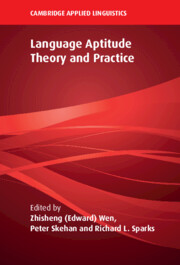Book contents
- Language Aptitude Theory and Practice
- The Cambridge Applied Linguistics Series
- Language Aptitude Theory and Practice
- Copyright page
- Contents
- Figures
- Tables
- Editors and Contributors
- Preface and Acknowledgments
- 1 Language Aptitude Research
- Part I Revisiting and Refining Aptitude Tests
- Part II Aptitude Testing of Diverse Groups
- Part III Innovative Perspectives and Paradigms
- Part IV Aptitude–Treatment Interaction (ATI)
- Part V Final Commentaries
- Index
- References
1 - Language Aptitude Research
From Testing to Theory and Practice
Published online by Cambridge University Press: 27 May 2023
- Language Aptitude Theory and Practice
- The Cambridge Applied Linguistics Series
- Language Aptitude Theory and Practice
- Copyright page
- Contents
- Figures
- Tables
- Editors and Contributors
- Preface and Acknowledgments
- 1 Language Aptitude Research
- Part I Revisiting and Refining Aptitude Tests
- Part II Aptitude Testing of Diverse Groups
- Part III Innovative Perspectives and Paradigms
- Part IV Aptitude–Treatment Interaction (ATI)
- Part V Final Commentaries
- Index
- References
Summary
In this introductory chapter, we first provide a brief overview of research paradigms of language aptitude testing and theory construction in the past six decades, summarizing the major achievements and innovations in research methodologies. Following this, we discuss the background and rationale of the current volume, highlighting the key contents of each chapter and evaluating their potential contributions to enhancing our understanding of language aptitude theory and practice. We conclude the introduction by calling upon scholars to work concertedly towards building an integrated language aptitude theory that will allow us to diagnose, predict, and explain the second language learning process and outcomes. Overall, the current volume calls for a paradigm shift of language aptitude research from its previous focus on aptitude testing to theory construction and practical applications.
Keywords
- Type
- Chapter
- Information
- Language Aptitude Theory and Practice , pp. 1 - 22Publisher: Cambridge University PressPrint publication year: 2023

